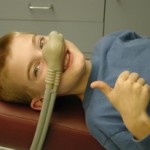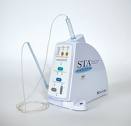 Hate having that “fat” lip feeling after your appointments with the Dentist? We’ve got a new way to go through pain free dentistry and not have a numb face! Our office just purchased a new system to administer anesthetic during dental visits. This system is called “The Wand”. The Wand numbs only very specific areas in your mouth where the Dentist is working that day. Instead of having the whole side of your face or lip numb, you will only be numb on the tooth they are working on that day. How great is that! The way it works is that an injection is given only in that specific area, numbing the teeth and tissues immediately surrounding that site. The injection is virtually pain free and the rest of your visit with us will be comfortable. You won’t even leave with a droopy lip or crooked smile! Talk with your doctor at your next visit to see if this might be right for you.
Hate having that “fat” lip feeling after your appointments with the Dentist? We’ve got a new way to go through pain free dentistry and not have a numb face! Our office just purchased a new system to administer anesthetic during dental visits. This system is called “The Wand”. The Wand numbs only very specific areas in your mouth where the Dentist is working that day. Instead of having the whole side of your face or lip numb, you will only be numb on the tooth they are working on that day. How great is that! The way it works is that an injection is given only in that specific area, numbing the teeth and tissues immediately surrounding that site. The injection is virtually pain free and the rest of your visit with us will be comfortable. You won’t even leave with a droopy lip or crooked smile! Talk with your doctor at your next visit to see if this might be right for you.
Elmbrook Family Dental
Pain Free Dentistry and the Smile to Match
March 4, 2010
Is Fluoride Right For You?
February 4, 2010
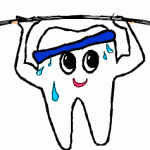 You may have heard many different things surrounding topic of fluoride. The truth is that the benefits of fluoride do not discriminate in age, gender, or ethnic background. It can be beneficial to all people if comsumed in moderate amounts. Fluoride is a common mineral in many of the foods you eat and drink daily, as well as in tap water of many local communities. Many families have started using bottled water as an alternative to their own tap water. Most bottled water is not a significant source of fluoride. Review the nutrition labels before purchasing your next case of water, or consider using tap water with a filtration system like Britta or Pur. These brands of filters will take out bad tastes and sediments, but leave the fluoride in. What are the benefits? When fluoride is ingested through food and water, it becomes systemic and is then secreted through your salivary glands. This means that as it comes out through your saliva, it is in direct contact with your teeth and will help fight against cavities and strengthen enamel! Its amazing how your body works! So, before you grab that next bottle of water, consider that you may be sacrificing something that will promote a healthier mouth. The links below will give you more information regarding fluoride and how to learn more about the water in your own communities. As always, your friendly staff at Elmbrook Family Dental is always here to answer any questions you may have. Call us any time or discuss your thoughts during your next dental visit.
You may have heard many different things surrounding topic of fluoride. The truth is that the benefits of fluoride do not discriminate in age, gender, or ethnic background. It can be beneficial to all people if comsumed in moderate amounts. Fluoride is a common mineral in many of the foods you eat and drink daily, as well as in tap water of many local communities. Many families have started using bottled water as an alternative to their own tap water. Most bottled water is not a significant source of fluoride. Review the nutrition labels before purchasing your next case of water, or consider using tap water with a filtration system like Britta or Pur. These brands of filters will take out bad tastes and sediments, but leave the fluoride in. What are the benefits? When fluoride is ingested through food and water, it becomes systemic and is then secreted through your salivary glands. This means that as it comes out through your saliva, it is in direct contact with your teeth and will help fight against cavities and strengthen enamel! Its amazing how your body works! So, before you grab that next bottle of water, consider that you may be sacrificing something that will promote a healthier mouth. The links below will give you more information regarding fluoride and how to learn more about the water in your own communities. As always, your friendly staff at Elmbrook Family Dental is always here to answer any questions you may have. Call us any time or discuss your thoughts during your next dental visit.
http://www.wda.org/categories/13-consumer-awareness/subcategories/24-fluoride/documents/41-fluoride-community-water-fluoridation
Oral Cancer
January 12, 2010
 Did you know that oral cancer is the cause of 7,000 deaths each year within the United States? World wide, it is responsible for 127,000 deaths total. One of the main reasons for this is that it is often not detected till it is in its late stages. Once it metastasizes, the survival rate is only 17%. Research shows that early detection is key to increasing a persons chances at surviving oral cancer. Who better to detect oral cancer at its earliest stages than your skilled team here at Elmbrook Family Dental? Coming in on a routine basis is not only helpful in keeping your teeth clean, but also in monitoring and detecting lesions. Oral cancer often presents as a tiny, unnoticed white or red spot or sore inside the mouth. Oral cancer can occur at any age to anyone. Those at higher risk are those over the age of 40, those who combine alcohol consumption with smoking, and those who have had prolonged exposure to the sun. Sun exposure can cause cancerous lesions on the lips. Oral cancer screenings are a routine part of your check ups with us. Your hygienist does a careful and detailed examination of your lips, cheeks and tongue. If there are any areas of concern, the dentist will examine the area to determine if there is a need for further diagnoses by a specialist. So, before you put your next visit with us off, think of what may be at risk. Put your health first and let us be the ones to help you.
Did you know that oral cancer is the cause of 7,000 deaths each year within the United States? World wide, it is responsible for 127,000 deaths total. One of the main reasons for this is that it is often not detected till it is in its late stages. Once it metastasizes, the survival rate is only 17%. Research shows that early detection is key to increasing a persons chances at surviving oral cancer. Who better to detect oral cancer at its earliest stages than your skilled team here at Elmbrook Family Dental? Coming in on a routine basis is not only helpful in keeping your teeth clean, but also in monitoring and detecting lesions. Oral cancer often presents as a tiny, unnoticed white or red spot or sore inside the mouth. Oral cancer can occur at any age to anyone. Those at higher risk are those over the age of 40, those who combine alcohol consumption with smoking, and those who have had prolonged exposure to the sun. Sun exposure can cause cancerous lesions on the lips. Oral cancer screenings are a routine part of your check ups with us. Your hygienist does a careful and detailed examination of your lips, cheeks and tongue. If there are any areas of concern, the dentist will examine the area to determine if there is a need for further diagnoses by a specialist. So, before you put your next visit with us off, think of what may be at risk. Put your health first and let us be the ones to help you.
Hunger Task Force Food Drive… Success!
December 7, 2009
 Our Hunger Task Force food drive that we hosted for the month of November was a huge success! We had so many donations that we had to bring in a second box. Employees from the entire building – some not even patients here – brought in food to donate. We had one patient who came in every day to donate!
Our Hunger Task Force food drive that we hosted for the month of November was a huge success! We had so many donations that we had to bring in a second box. Employees from the entire building – some not even patients here – brought in food to donate. We had one patient who came in every day to donate!
We were very happy to help feed the hungry families of Wisconsin this cold winter. Thank you so much for your donations and your support!
Congratulations to Brandon B. and Nancy S., both were our food drive whitening winners! Brandon won the whitening specifically to give to his wife, how sweet!
Great Gift Ideas!
November 30, 2009
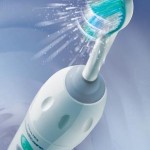 Tis the season for gift giving and we’ve got some great ideas for you! Who says you can’t give the gift of a great oral hygiene? Here at the office, we sell some wonderful products at the best prices around. We price shopped the closest department stores to be sure our prices are the lowest on things like Sonicare toothbrushes and Waterpiks. Waterpik is a great product for people with braces or bridges in their mouth. It can even help those who have a hard time committing to flossing. (we still recommend flossing over anything else!) Sonicare toothbrushes are rechargeable electric toothbrushes, great for anyone. We carry the Sonicare Flex and Sonicare Healthy here at the office. You can visit their web site to view these models. Aside from these 2 great products, our patients in the past have surprised their loved ones by pre-paying for custom whitening trays! We’ll take $100 off when you purchase these. An appointment is necessary to begin making the trays by taking impressions, so call to schedule today! We wish you all a safe and wonderful holiday season.
Tis the season for gift giving and we’ve got some great ideas for you! Who says you can’t give the gift of a great oral hygiene? Here at the office, we sell some wonderful products at the best prices around. We price shopped the closest department stores to be sure our prices are the lowest on things like Sonicare toothbrushes and Waterpiks. Waterpik is a great product for people with braces or bridges in their mouth. It can even help those who have a hard time committing to flossing. (we still recommend flossing over anything else!) Sonicare toothbrushes are rechargeable electric toothbrushes, great for anyone. We carry the Sonicare Flex and Sonicare Healthy here at the office. You can visit their web site to view these models. Aside from these 2 great products, our patients in the past have surprised their loved ones by pre-paying for custom whitening trays! We’ll take $100 off when you purchase these. An appointment is necessary to begin making the trays by taking impressions, so call to schedule today! We wish you all a safe and wonderful holiday season.
Sonicare web site: http://sonicare.com/default.asp
Waterpik web site: http://sonicare.com/default.asp
*note: its a good idea to call ahead to be sure the product of your choice is in stock before stopping in
Helping Others
November 17, 2009

During this time of year as the weather begins to get colder and the holidays fastly approach, it is important to step back and examine the needs of others. As you may know, we have been collecting food donations for the hunger task force here in our office. Our donation bucket is 3/4 quarters full! We are so thankful to all of you who have taken the time to stop in and donate!
Aside from feeding the hungry, another cause in need of attemtopm is HIV and AIDS awareness. In our neighboring state of Minnesota, as well as sometimes New York and California, Camp Heartland is a safe and understanding place for young people to find support. Many of the children who attend these camps are surviving with the HIV and AIDS virus. Others who attend have family members infected with this disease and come to the camp for education and support from camp counselors and peers. Children are flown to these locations from their home towns to spend part of their summer. The travel and camp is paid for by donations alone. Between 8am today (11-17-09) and 8am tomorrow (11-18-09) a company has pledged to match anyone’s donation, dollar for dollar to help the children in need. You can visit their web site at: www.givemn.org and donate to One Heartland. They accept donations year round.
Little by little, we can all make a big difference!
Elmbrook Family Dental & the Hunger Task Force
November 3, 2009
 We are very excited to announce that for the month of November we will be accepting donations for the Hunger Task Force in our office! In appreciation of your generous donation we will be giving you an entry to win free teeth whitening! Our regular monthly drawing for the month of November will be not be available… the only way to earn an entry this month is to donate! So please stop in with your non-perishables to donate and get your teeth whitening entry form filled out!
We are very excited to announce that for the month of November we will be accepting donations for the Hunger Task Force in our office! In appreciation of your generous donation we will be giving you an entry to win free teeth whitening! Our regular monthly drawing for the month of November will be not be available… the only way to earn an entry this month is to donate! So please stop in with your non-perishables to donate and get your teeth whitening entry form filled out!
There is a limit of one entry form per person per day, although you can donate as much as you’d like each day. If you want to increase your chances of winning, stop by every day in the month of November to donate!
Cavity Causing Bacteria in Babies
October 30, 2009
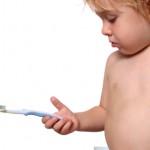 Whoa baby! We’ve had many patients and even one of our own team members’ welcome new babies into the world just within the last few months. Along with all the other many things to learn about at this exciting time in their lives, we cannot forget about protecting those infants against cavities! You may be thinking: “Cavities?! My baby doesn’t even have teeth yet!” Though their teeth may not begin to erupt until they are near 6 months of age, it is not too early to start their preventative care. Before an infant is even born, they are already acquiring flora or ‘normal’ bacteria from their mothers. After birth, they are introduced to even more bacteria through contact with their mothers and other family members. The cavity causing bacteria named S. mutans is passed from person to baby through fingers, airborne saliva droplets and even kissing those cute baby faces! That’s right; the flora in your own mouth can be passed along to your new borns. Once the bacteria are introduced, there is no removing it entirely. Your job as parents will simply be to limit the amount of exposure your baby receives, and minimize the bacteria daily by keeping up on your infants oral hygiene. Before teeth erupt, a wet wash cloth can be used inside of their mouth by gently sweeping along their gums and cheeks. Once the teeth are in, a soft infant tooth brush can be used either with water, or non-fluoridated toothpaste. By reducing the amount of S. mutans bacteria in your baby’s mouth, you can lower their chances at having cavities early in their childhood. Next time you’re in to visit one of our hygienists, ask them for recommendations on the best hygiene aids for your child!
Whoa baby! We’ve had many patients and even one of our own team members’ welcome new babies into the world just within the last few months. Along with all the other many things to learn about at this exciting time in their lives, we cannot forget about protecting those infants against cavities! You may be thinking: “Cavities?! My baby doesn’t even have teeth yet!” Though their teeth may not begin to erupt until they are near 6 months of age, it is not too early to start their preventative care. Before an infant is even born, they are already acquiring flora or ‘normal’ bacteria from their mothers. After birth, they are introduced to even more bacteria through contact with their mothers and other family members. The cavity causing bacteria named S. mutans is passed from person to baby through fingers, airborne saliva droplets and even kissing those cute baby faces! That’s right; the flora in your own mouth can be passed along to your new borns. Once the bacteria are introduced, there is no removing it entirely. Your job as parents will simply be to limit the amount of exposure your baby receives, and minimize the bacteria daily by keeping up on your infants oral hygiene. Before teeth erupt, a wet wash cloth can be used inside of their mouth by gently sweeping along their gums and cheeks. Once the teeth are in, a soft infant tooth brush can be used either with water, or non-fluoridated toothpaste. By reducing the amount of S. mutans bacteria in your baby’s mouth, you can lower their chances at having cavities early in their childhood. Next time you’re in to visit one of our hygienists, ask them for recommendations on the best hygiene aids for your child!
The Toothbrush!
October 20, 2009
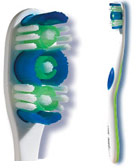 Did you know that the first toothbrushes were used as long ago as 3000BC? They were made with wild boar hair which served as a stiff bristles to help clean biofilm off of teeth. Throughout history many other things have been used as well. Everything from horse hair toothbrushes to the Miswaak stick which naturally contains calcium and fluoride. Today we have evolved to the nylon bristled brush that comes in many shapes and forms. A good toothbrush will be based on each patient’s individual needs. Take a walk down the toothbrush isle and see how many options there are! The style of brush is not as significant as the type of bristle. Soft or extra soft bristles play an important role in maintaining your optimum tooth and gum health. You may be tempted to try medium or hard bristles, but these can cause recession and abrasion. Soft is still a better way to go! Next time you’re out shopping for your next toothbrush, take a look at all the options out there. You may just find you’ll like something new. Remember the most important thing is that you are brushing twice daily for 2 or more minutes at a time. The best times to visit your dentist are during preventative and routine care visits! Good oral hygiene can help keep your visits to us at a minimum.
Did you know that the first toothbrushes were used as long ago as 3000BC? They were made with wild boar hair which served as a stiff bristles to help clean biofilm off of teeth. Throughout history many other things have been used as well. Everything from horse hair toothbrushes to the Miswaak stick which naturally contains calcium and fluoride. Today we have evolved to the nylon bristled brush that comes in many shapes and forms. A good toothbrush will be based on each patient’s individual needs. Take a walk down the toothbrush isle and see how many options there are! The style of brush is not as significant as the type of bristle. Soft or extra soft bristles play an important role in maintaining your optimum tooth and gum health. You may be tempted to try medium or hard bristles, but these can cause recession and abrasion. Soft is still a better way to go! Next time you’re out shopping for your next toothbrush, take a look at all the options out there. You may just find you’ll like something new. Remember the most important thing is that you are brushing twice daily for 2 or more minutes at a time. The best times to visit your dentist are during preventative and routine care visits! Good oral hygiene can help keep your visits to us at a minimum.
N2O2
October 16, 2009
Did you know that our office offers Nitrous Oxide? Sometimes referred to as “laughing gas”. Perhaps for those of you who have not had the best dental experiences in the past, this can be a great option to help relax you during dental procedures. Aside from our already friendly staff, the TV’s in each room, neck pillows, massage chairs and sometimes even a malt or shake after more difficult procedures, some patients still need a little extra help to relax.
N2O2 was first used in dentistry in 1844. Today its uses have been expanded to many other things like whipped cream, auto racing and even scuba diving. The way it works here at the office is simple. Once you arrive to the office, we’ll recline you back to a comfortable position and place the nose shield on. Once you’ve taken a few deep breaths in, you’ll begin to feel much lighter and relaxed, making your whole appointment much more enjoyable. Before we release you, we turn the oxygen which will make you feel normal and alert. You will be fully capable of driving once you leave the office.
If you think you may be interested in using this for any of your next appointments, call our front desk staff to discuss this option. We are happy to do anything to make your next procedure as enjoyable as possible!
